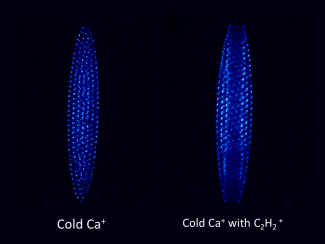In addition to the pure calcium Coulomb crystals that we can form by laser cooling and trapping Ca+ ions, we can also load other cations of interest into the trap. These molecular cations are sympathetically cooled by Coulomb repulsion with the Ca+. The mixed and pure Coulomb crystals can remain cold and trapped for hours at a time, including while exposed to trace amounts of room temperature neutral gas. Any charged products formed as a result of collisions between the trapped ions and neutral gas are also trapped and cooled. We are able to monitor the reactions that occur between the trapped ions and warm neutral gas through fluorescence microscope images and high-resolution time-of-flight mass spectrometry. This combination of techniques form a sensitive and unique environment for physical chemistry and chemical physics.



 The Physics Frontiers Centers (PFC) program supports university-based centers and institutes where the collective efforts of a larger group of individuals can enable transformational advances in the most promising research areas. The program is designed to foster major breakthroughs at the intellectual frontiers of physics by providing needed resources such as combinations of talents, skills, disciplines, and/or specialized infrastructure, not usually available to individual investigators or small groups, in an environment in which the collective efforts of the larger group can be shown to be seminal to promoting significant progress in the science and the education of students. PFCs also include creative, substantive activities aimed at enhancing education, broadening participation of traditionally underrepresented groups, and outreach to the scientific community and general public.
The Physics Frontiers Centers (PFC) program supports university-based centers and institutes where the collective efforts of a larger group of individuals can enable transformational advances in the most promising research areas. The program is designed to foster major breakthroughs at the intellectual frontiers of physics by providing needed resources such as combinations of talents, skills, disciplines, and/or specialized infrastructure, not usually available to individual investigators or small groups, in an environment in which the collective efforts of the larger group can be shown to be seminal to promoting significant progress in the science and the education of students. PFCs also include creative, substantive activities aimed at enhancing education, broadening participation of traditionally underrepresented groups, and outreach to the scientific community and general public.